The phrase “What is the past tense of panic” refers to the grammatical transformation of the verb panic when expressing an action that happened in the past. In English, panic is considered a regular verb, but due to its unique spelling, its past tense form becomes panicked—with a “k” added before “-ed” to maintain proper pronunciation. This slight alteration often causes confusion, especially among learners who aren’t familiar with English spelling rules.
When someone reads or hears panicked, it immediately conveys a vivid scene of emotional intensity—moments when fear takes over, and rational thought disappears. This small grammar detail packs a big emotional punch, making the word not only useful in writing but also powerful in storytelling and everyday speech. That’s what makes understanding this past tense more than just a grammar lesson—it’s a tool for vivid communication.
Knowing the proper usage of panic and panicked improves both writing and speaking fluency. It helps people describe past emotional reactions accurately and enhances clarity in conversations, narratives, or even academic writing. Mastering this verb’s tense also prevents common grammar mistakes, allowing your language to sound polished and precise.
Let’s dive into everything you need to know about panic, from its fascinating etymology to its correct usage across various parts of speech, complete with real-world examples that will help you use this word with confidence.
Understanding “Panic” as a Word
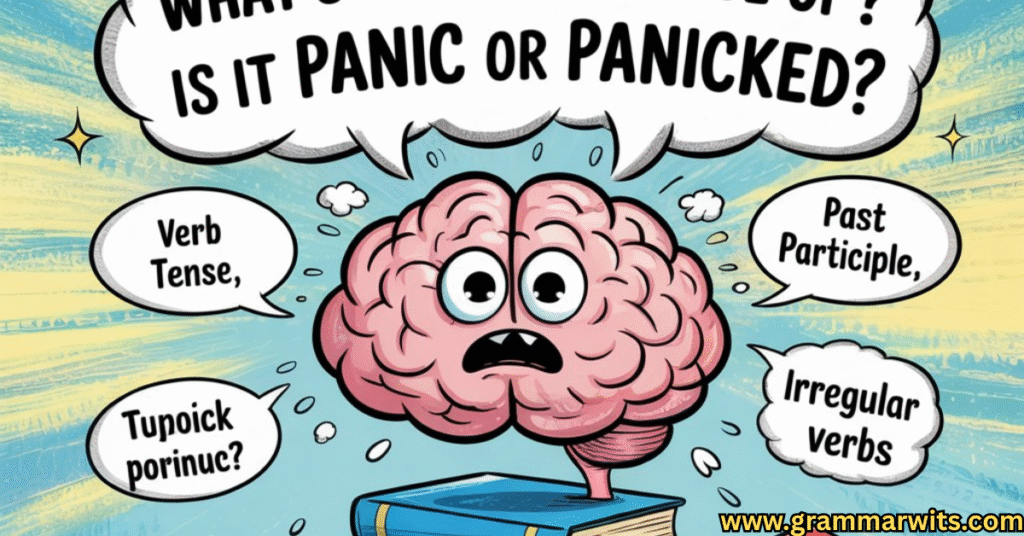
Before we tackle the past tense of panic, let’s understand what this powerful little word means and where it comes from.
The word “panic” has ancient roots, deriving from the Greek “panikos,” associated with the god Pan. In Greek mythology, Pan was known to cause sudden fear in travelers passing through forests, creating what we now call “panic.”
“Panic” as a Noun
As a noun, panic refers to a sudden overwhelming feeling of fear or anxiety that can cause wildly unthinking behavior.
Examples of panic as a noun:
- The fire alarm triggered panic throughout the building.
- Financial markets experienced a brief panic after the announcement.
- She felt a rising sense of panic when she realized she’d lost her passport.
“Panic” as a Verb
When used as a verb, panic means to be affected by panic or to feel panic.
Examples of panic as a verb:
- Don’t panic if you see a spider; most are harmless.
- The investors started to panic when stock prices plummeted.
- She tends to panic before public speaking events.
“When we panic, we make poor decisions. When we prepare, we create options.” — Unknown
The Definitive Answer: Past Tense of Panic
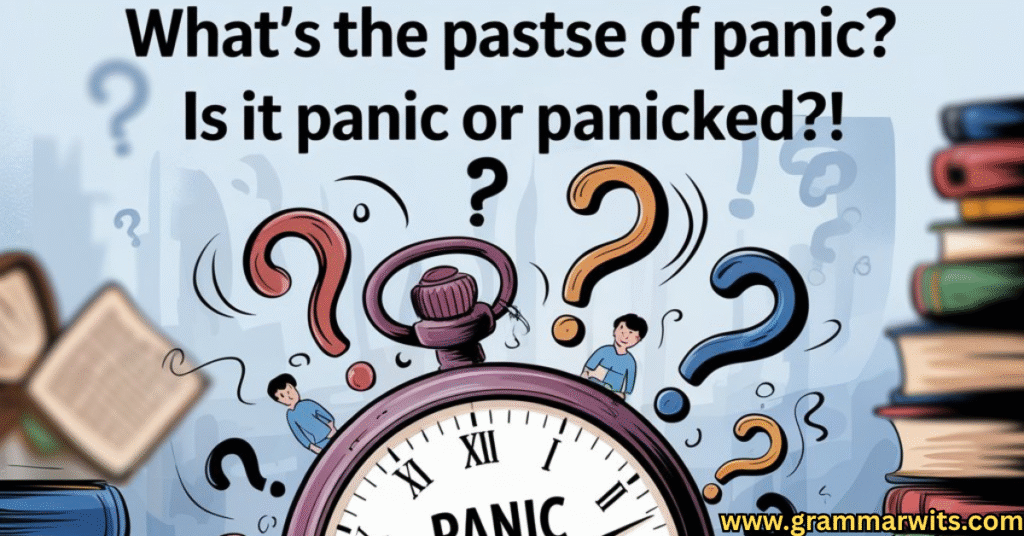
What is the past tense of panic? The past tense is definitely “panicked” – with a “ck” ending, not just “paniced” with a “c.”
This follows an important grammar rule for English verbs ending in “c”: when forming the past tense or past participle, we add “ked” rather than just “ed.” This rule exists to maintain the hard “k” sound of the “c.”
- Present tense: I panic
- Past tense: I panicked
- Past participle: I have panicked
The spelling “paniced” is incorrect because in English, when a single-syllable verb ends with a consonant-vowel-consonant pattern (like pan-i-c), we typically double the final consonant before adding “-ed” or “-ing.” However, since “c” alone wouldn’t preserve the correct pronunciation, it changes to “ck.”
What is the past tense of panic? Remember: it’s “panicked” with “ck,” never “paniced” with just “c.”
Conjugation of “Panic” Across All Tenses
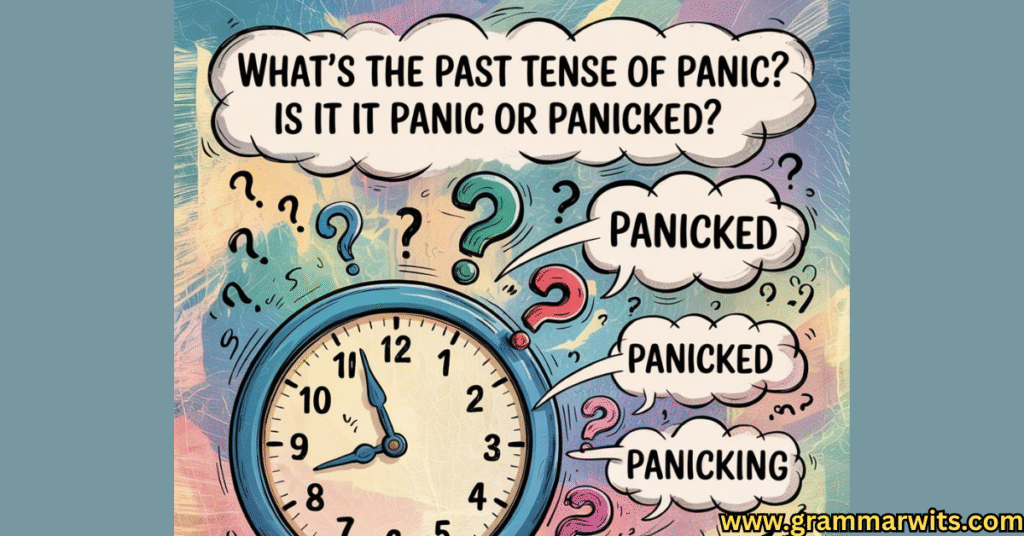
Understanding the full verb conjugation of panic helps place the past tense in context. Here’s a comprehensive table showing all forms:
| Tense | Form | Example |
|---|---|---|
| Simple Present | panic/panics | I panic when I see spiders. He panics easily. |
| Simple Past | panicked | They panicked during the power outage. |
| Present Perfect | have/has panicked | She has panicked unnecessarily. |
| Past Perfect | had panicked | We had panicked before realizing it was a false alarm. |
| Future | will panic | I will panic if I miss the deadline. |
| Present Continuous | am/is/are panicking | They are panicking about the test. |
| Past Continuous | was/were panicking | He was panicking when I called. |
| Future Perfect | will have panicked | By midnight, everyone will have panicked needlessly. |
This chart clearly shows that “panicked” is the correct form when discussing actions that occurred in the past. What is the past tense of panic? It’s “panicked” in all contexts of past action.
Pronunciation Guide

Pronouncing panic and panicked correctly is just as important as spelling them right.
- Panic is pronounced /ˈpænɪk/ (PAN-ik) with the stress on the first syllable.
- Panicked is pronounced /ˈpænɪkt/ (PAN-ikt), essentially adding a “t” sound to the end.
The word stress remains on the first syllable in both forms. Many English learners struggle with the past tense pronunciation because the “ed” ending is pronounced as simply “t” rather than as a separate syllable.
Pro Tip: When pronouncing “panicked,” don’t add an extra syllable. It’s not “pan-ik-ed” but rather “pan-ikt” with the “t” sound blending with the “k.”
Using “Panicked” in Context
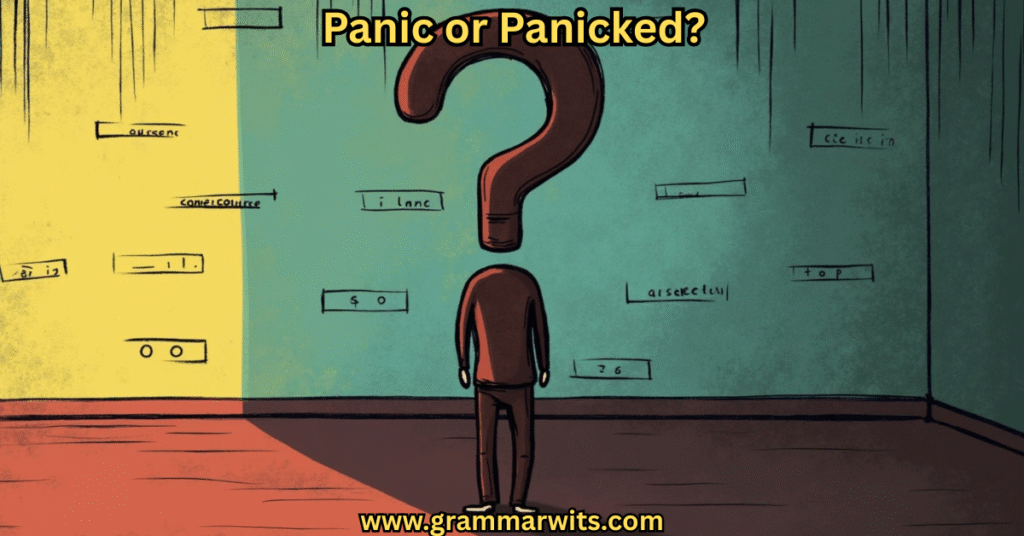
Seeing “panicked” used correctly in sentences helps cement your understanding of this past tense form. Here are some examples showing proper usage:
- The crowd panicked when they heard the explosion.
- She panicked and forgot her lines during the play.
- The small business owner panicked after seeing the quarterly losses.
- When the power went out, nobody panicked, which surprised me.
Notice how in each case, “panicked” refers to a completed action that occurred in the past. What is the past tense of panic? It’s “panicked,” and these examples show how naturally it fits into sentences describing past events.
Literary Examples
Even accomplished writers use “panicked” in their works:
- “He panicked at the thought of being alone in the dark house.” — Stephen King
- “The birds panicked and took flight at the sudden noise.” — Margaret Atwood
News Headlines
Headlines also frequently use the past tense form:
- “Investors Panicked After Fed Announcement“
- “Passengers Panicked When Turbulence Hit Flight 237″
Panic vs. Panicked vs. Panicking: Understanding the Differences
Let’s clarify the differences between these forms with examples:
| Form | Part of Speech | Example Usage |
|---|---|---|
| Panic | Noun | The panic spread quickly through the crowd. |
| Panic | Present tense verb | I panic whenever I have to speak publicly. |
| Panicked | Past tense verb | He panicked when he saw the bill. |
| Panicked | Adjective (past participle) | The panicked shoppers rushed for the exits. |
| Panicking | Present participle | They are panicking about the upcoming deadline. |
What is the past tense of panic? Looking at this table confirms it’s “panicked,” which can function both as a verb in past tense and as an adjective describing someone in a state of panic.
Similar Verbs That Follow This Pattern
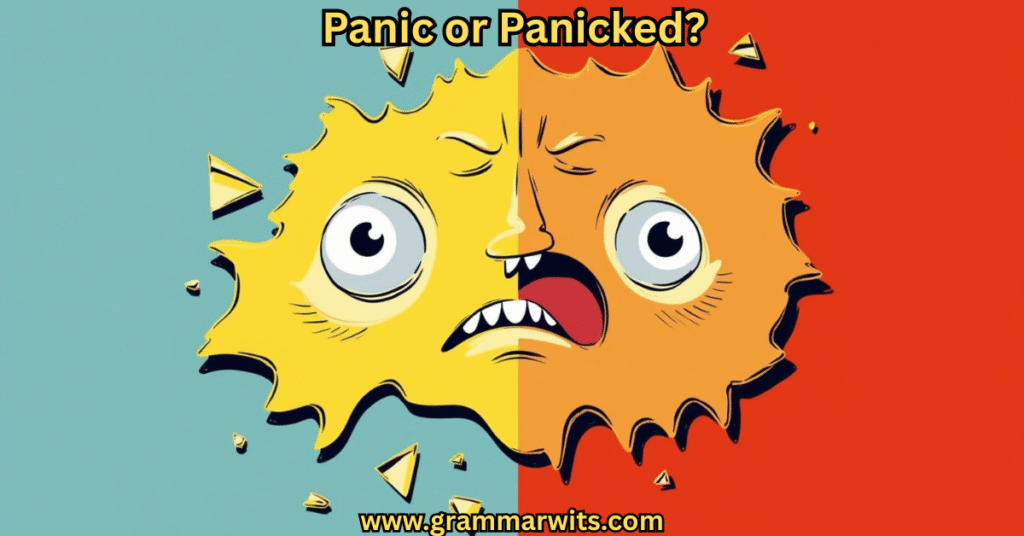
Panic isn’t the only verb that follows this spelling pattern. Here are other verbs ending in “c” that follow the same rule:
- Mimic → Mimicked
- Picnic → Picnicked
- Traffic → Trafficked
- Frolic → Frolicked
Understanding these patterns helps reinforce that “panicked” is correct. These are all examples of regular verbs that follow predictable patterns, despite their slightly unusual spelling changes.
What is the past tense of panic? Just as “mimicked” is the past tense of “mimic,” “panicked” is the past tense of “panic.”
British vs. American English Considerations
Good news for international English users: both British and American English agree on the spelling of “panicked.” This consistency across major English variants makes it easier to remember.
While some verbs have different past tense forms in different English dialects (like “learned” vs. “learnt”), “panicked” remains constant regardless of which English variant you’re using.
What is the past tense of panic? Whether you’re writing for a British or American audience, “panicked” is the correct form.
Transitive and Intransitive Uses
Panic can function as both a transitive and intransitive verb, which affects how it’s used:
- Intransitive: The subject performs the action without a direct object.
- Example: “The children panicked during the storm.”
- Transitive: The action affects a direct object.
- Example: “The sudden noise panicked the horses.”
In both cases, the past tense of panic remains “panicked.”
Synonyms and Alternative Expressions
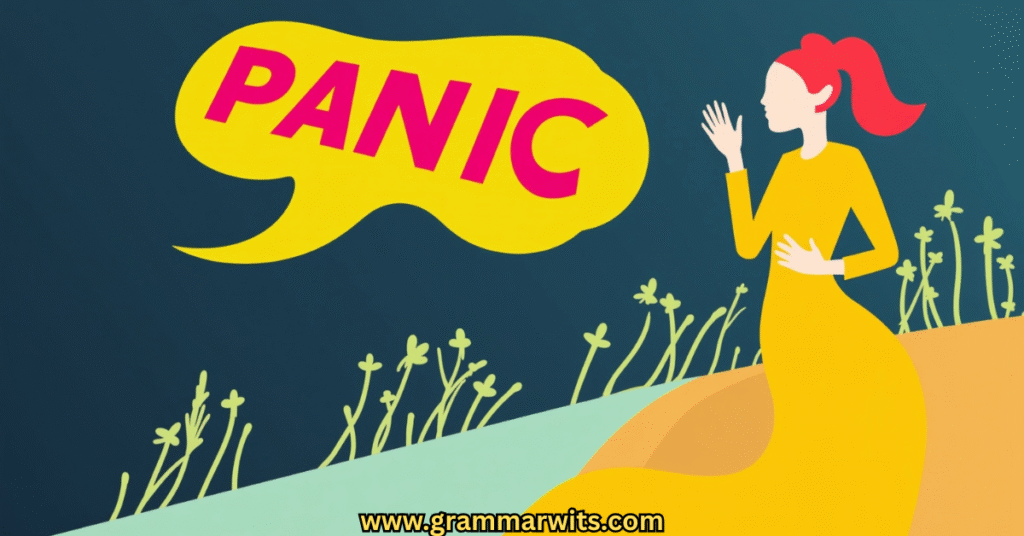
When writing, it’s helpful to have alternatives to “panicked” for variety and precision. Here are some synonyms with slightly different connotations:
- Freaked out (informal)
- Became alarmed
- Grew anxious
- Was terrified
- Lost composure
- Became frantic
- Grew intense
- Was startled
- Became unnerved
- Got flustered
Each of these alternatives carries slightly different meanings within the spectrum of emotion and language, allowing for more precise communication.
“The ability to stay calm instead of panicking is often what separates success from failure in critical moments.” — Emergency response training manual
Common Phrases with “Panicked”
These phrases use “panicked” in everyday speech:
- Panicked reaction
- Panicked state
- Panicked phone call
- Panicked look
- Panicked decision
What is the past tense of panic? These common phrases confirm that we use “panicked” when referring to past states of panic.
Practical Case Study: News Reporting
News outlets frequently describe crisis situations using forms of “panic.” Let’s examine a paragraph from a hypothetical news report:
“When the fire alarm sounded, shoppers initially remained calm. However, as smoke became visible, many panicked and rushed toward the exits. Store employees, who had received emergency training, didn’t panic. Instead, they calmly directed the panicking customers to safety. Their composed response prevented a full-scale panic.”
This passage demonstrates how different forms of the word are used:
- “panicked” (past tense verb)
- “panic” (present tense verb)
- “panicking” (present participle)
- “panic” (noun)
Etymology and Language Evolution
The lexical semantics around “panic” have evolved over centuries. The word entered English in the early 17th century, derived from the French “panique,” which itself came from Greek “panikos” relating to the god Pan.
The verb form came later, and by the 18th century, people were regularly using “panicked” as the past tense. This evolution follows patterns seen in morphology, where nouns often become verbs through a process called “verbing.”
What is the past tense of panic? Historical linguistic evidence confirms that “panicked” has been the standard past tense form for centuries.
FAQ Section
Is “paniced” ever correct?
No, “paniced” is always incorrect. The proper spelling is “panicked” with “ck.”
Can “panic” ever be used as past tense?
No, “panic” is never correct as a past tense form. “I panic yesterday” is grammatically incorrect. The correct form is “I panicked yesterday.”
What’s the difference between “I was panicked” and “I panicked”?
“I was panicked” suggests a state (possibly caused by something else), while “I panicked” describes an action you performed. Both use the word “panicked,” but in different grammatical constructions.
Is “panicking” spelled with one or two Ks?
“Panicking” is spelled with one “k.” This differs from “panicked,” which uses “ck.”
What’s the past participle of panic?
The past participle is “panicked,” as in “I have panicked before.”
Why does “c” change to “ck” in the past tense?
The “c” changes to “ck” to preserve the hard “k” sound. Without the “k,” the “c” followed by “e” might be pronounced as an “s” sound (like in “racing”).
Quick Reference Guide
Here’s a handy reference table for quick reminders about panic forms:
| Form | Usage | Example |
|---|---|---|
| Panic (noun) | A sudden fear or anxiety | The panic lasted only minutes. |
| Panic (verb) | Present tense action | I panic when I see heights. |
| Panicked | Past tense action | We panicked unnecessarily. |
| Panicked | Adjective form | The panicked response made things worse. |
| Panicking | Ongoing action | They are panicking over nothing. |
| Have/has/had panicked | Perfect tense forms | She has panicked in similar situations. |
What is the past tense of panic? According to this reference guide, it’s clearly “panicked.”
The Psychology of Panic and Language
Interestingly, the way we discuss panic affects how we process fear-inducing situations. The ability to accurately describe our emotional states using precise language (like correctly using “panicked” to describe past fear) can help process and manage those emotions.
Emotion and language are intimately connected. When we can name our experiences correctly, we gain a sense of control over them. This makes precise grammar not just a matter of correctness, but potentially a tool for emotional regulation.
Conclusion
What is the past tense of panic? As we’ve thoroughly explored throughout this article, the answer is definitively “panicked.”
Understanding verb forms like the past tense of panic might seem like a small detail, but precision in language leads to clearer communication. Whether you’re writing an academic paper, crafting a story, or simply recounting yesterday’s events, knowing when and how to use “panicked” correctly enhances your credibility and ensures your meaning comes across as intended.
Remember these key points:
- “Panic” is the base/present form
- “Panicked” is both the past tense and past participle
- “Panicking” is the present participle
- Never use “paniced” with just a “c”
Language evolves, but some rules remain steadfast. The spelling and usage of “panicked” has remained consistent for centuries, making it one of the more reliable aspects of English grammar rules—even if it does trip us up from time to time.
Now you can confidently tell others what the past tense of panic is, without panicking yourself!
Additional Resources
Want to learn more about English verbs and their conjugations? Check out these helpful resources:
These trusted sources can help you navigate other tricky verb forms and grammar rules.

Alizy Smith is a passionate language enthusiast and the admin of Grammar Wits. With a love for wordplay, grammar quirks, and witty expressions, she’s dedicated to making language learning fun and accessible. From grammar tips to pun-filled laughs, Alizy ensures every piece of content entertains while educating — turning tricky rules into easy, enjoyable reads.
